All in one
Director's Corner
We're making inroads on equity and safety

Tony Tavares
Greetings, Team Caltrans, and welcome to our departmental e-newsletter, CT News. In this issue I want to briefly describe two of Caltrans' most important and exciting undertakings, one of them getting into gear this month and the other is seeing a major upgrade.
Earlier this month in rural San Diego County, Caltrans began constructing the first leg of the 10,000-mile broadband network aimed at bringing high-speed internet services to all Californians so they can access emergency information, telehealth services, education and employment. We are proud to support the California Department of Technology's (CTD’s) efforts to create this $3.25 billion “Middle-Mile Network,” which Gov. Gavin Newsom signed into law (Senate Bill 156) last year.
The initiative will build, operate and maintain an open access, state-owned middle mile network – high-capacity fiber lines that carry larger amounts of data at higher speeds over longer distances among local networks. On Oct. 13, several state officials including CalSTA Secretary Toks Omishakin gathered beside State Route 67 as the first 500 feet of fiber optic cable was blown through conduit in the network’s first segment.
While Caltrans is mostly known for our roads and highways, we are also about connecting people in other ways. That is exactly what the broadband middle-mile initiative comes down to – connecting people.
I also want to talk about safety, which as we all know is our top priority at Caltrans. Recently in a department-wide email, I announced that we are implementing the Safe System Approach to guide how we respond to our goal to eliminate fatalities and serious injuries on all California roadways by 2050.
This approach includes accounting for human mistakes that we know will result in crashes — and building a more forgiving system to minimize the severity of damage. It’s about taking more proactive measures — as well as reactive measures based on data — to improve safety. And it involves building more resilience into the system, so if one part fails, overlapping parts are in place to protect people.
Learn more about the Safe System Approach by accessing this facts sheet (PDF).
Thanks for all your good work. Enjoy this edition of CT News, make the most of California’s beautiful fall season, and stay safe.
News
High-altitude toads get top-class crossings
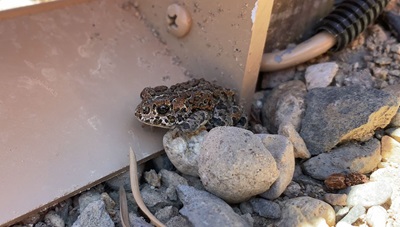
A Yosemite toad negotiates its way about human-made structures near State Route 108.
Photo by District 9By Joe Reidhead
District 9 public information officer
Along State Route 108 in Mono County lies the remote Upper Sardine Meadow. Rushes and sedges dominate this 2-acre wetland complex at 9,100 feet in elevation, while sagebrush and lodgepole pine frame its edges.
Meadow residents include black bears, mule deer, red foxes and various species of rodents, birds and amphibians. Passing drivers can take in this unique habitat from nearby Sonora Pass – the second-highest paved crossing in California at 9,624 feet and a waypoint for hikers on the Pacific Crest Trail.
Hidden among the knee-high flora of this meadow is a community of Yosemite toads, toadlets and tadpoles. The meadow is home to one of the largest populations of breeding Yosemite toads within the Humboldt-Toiyabe National Forest.
The species is found only above 7,700 feet in elevation and within a 150-mile range of California’s Sierra Nevada, from Fresno County to Alpine County. Juveniles are the size of a grape, and the largest females are the size of a tangerine. Dark spots cover the toads’ bumpy skin, with yellow, orange and green hues filling the gaps.
Studies have demonstrated that the Yosemite toad has suffered a range-wide population loss and has declined or disappeared from over 50 percent of its known habitat. Due to its dwindling numbers, the U.S. Fish & Wildlife Service (USFWS) listed the toad as a threatened species under the Federal Endangered Species Act in 2014.
The Project
In 2016, biologists with the Humboldt-Toiyabe National Forest initiated mark and recapture surveys to track Yosemite toad populations along State Route 108 in Mono County. During their first survey, they noticed a problem at Upper Sardine Meadow, a federally designated critical habitat for the Yosemite toad.
Adult and juvenile toads regularly cross the road during the breeding season and winter migration. “Immediately, we noticed a lot of amphibian carnage along the road in Upper Sardine Meadow,” said Rachel Van Horne, one of the Forest Service biologists. “Every day we went up to survey, we saw fresh carcasses on the road.”
An opportunity to reduce toad mortality arose in 2018 when the District 9 Caltrans Highway Maintenance Unit programmed a routine repaving project for this section of SR-108.
“From the project’s inception, our staff began communicating and consulting with the USFWS on potential mitigation strategies for the Yosemite toad,” said Dannique Aalbu, the Caltrans biologist for the project.
Caltrans maintenance staff and biologists observed that some toads kept trying to use an existing drop-inlet drainage culvert. However, the culvert design did not accommodate amphibians. A vertical drop into the uphill side of the culvert caused toads to get stuck and expend valuable energy trying to pass through it.
The nearby Sonora Junction Maintenance Crew created a toad entrance and exit ramp for the culvert, which did alleviate the problem of falling and trapped toads. However, only a limited area of the meadow benefited from the alteration.
“We started thinking about how to add a toad-specific crossing into the maintenance project,” said Katie Rodriguez, biology branch chief for District 9. “Our district is always on the lookout for opportunities to add wildlife-friendly infrastructure appropriate to ongoing projects. Including it in an existing project is much cheaper than doing a separate project specifically for a wildlife crossing.
“We’ve made huge strides in developing and implementing a framework to identify and address wildlife connectivity issues around our roads.
“Additionally, District 9 staff thought the crossing structures could serve as a partnership-building opportunity and an innovative solution to a roadkill hotspot along this stretch of highway,” added Aalbu.
Early on, Caltrans formed a working group that included USFWS, United States Forest Service (USFS), United States Geological Survey (USGS), and American Rivers. These partners had the subject area and research expertise to ensure the project would have long-lasting benefits. Further, the partners could seek funding opportunities to support research into the effectiveness of the structures.
Caltrans biologists also collaborated with design engineers to create two low-cost experimental crossing structures that would be incorporated into the paving project. The first undercrossing is a standard cattleguard with one modification: no side wings (and no corresponding livestock fence). The second undercrossing includes two sets of eight 6-inch-wide halfpipe culverts placed in a concrete slab.
When construction started in the summer of 2020, the crossings were pre-fabricated off-site and dropped into the road. The structures are 50 feet away from each other, the ideal spacing to provide small wildlife with convenient, stress-free crossing opportunities.
A critical feature of any wildlife crossing is an exclusionary fence. Caltrans’ environmental and maintenance staff worked together to install the 18-inch-high and 6-inch-deep Animex wildlife fence to funnel toads and other small creatures into the undercrossings.
To avoid accidental take and accommodate equipment needs and weather, they installed the fence just before the winter closure of Sonora Pass in 2021. The solid plastic amphibian-specific fence extends 50 feet beyond each crossing. It includes standard features such as turnarounds at the terminal ends and jumpouts (one-way off-ramps from the road to the meadow) in case a wayward toad finds itself on the road.
The fences and crossings create a 170-foot-long barrier on either side of the road. Though this length does not cover the entire meadow, it created a wildlife barrier in the main wetland corridor where most roadkill occurred.
When the toads entered winter hibernation, Caltrans and its partners finalized their plan for measuring the effectiveness of the structures. The trickiest task would involve gathering reliable data on these small amphibians and their use of the crossings.
The Research
“A juvenile is entering the crossing,” exclaimed Aalbu. Along with Whitney Philbrook, another Caltrans biologist, Aalbu was on site to replace camera batteries and exchange memory cards. A yard behind her, tadpoles squiggled in a 3-inch deep puddle of water amidst the meadow’s rushes.
The toad quickly disappeared into the halfpipe crossing. Toads don’t hop; they crawl. The juvenile made swift progress and crossed under half the road’s width within a minute.
Existing research into the crossing preferences and habits of Yosemite toads is limited, but the new crossings presented a unique opportunity to conduct original research and answer several questions, including:
Do the toads use the crossings, including females, males, adults and juveniles?
Do the structures and fencing reduce toad roadkill?
Do the toads prefer one style of structure over the other?
Does other wildlife use the crossings?
“Some studies have suggested that light may trigger Yosemite toad activity and movement,” Aalbu explained, “so the cattleguard is considered likely beneficial because light during the daytime shines completely through.”
The partners needed to track and analyze the toads’ movements to answer these questions. However, collecting accurate movement data on such small creatures with off-the-shelf wildlife tracking products is difficult.
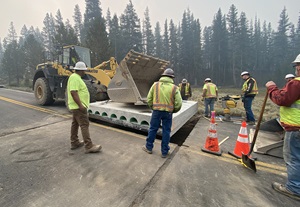
Crews insert the toad crossing structure into State Route 108.
Photo by District 9Most wildlife tracking cameras used by researchers rely on passive infrared (PIR) triggers, which detect mammals through a combination of heat and motion. PIR cameras can accurately capture large and medium-sized mammals and are regularly used in Caltrans monitoring projects. Unfortunately, PIR lacks the precision and sensitivity to detect ectotherms (amphibians, reptiles, and invertebrates) and small mammals such as voles. The District 9 team knew that their standard wildlife cameras would not be capable of reliably capturing toad movement. So they reached out to Cheryl Brehme, their partner at the USGS and a wildlife crossing specialist.
“Cheryl has been instrumental as a knowledge base for us in how to monitor the use of the structures,” Aalbu said. “She put us in touch with San Jose-based Hobbs Ecology. Hobbs manufactures specialized wildlife cameras to capture the movements of small animals.”
Michael Hobbs came to the world of wildlife monitoring after a career as a Navy pilot. A concern for threatened and endangered species inspired him to design data capture solutions for otherwise overlooked species. Seeing the limits of PIR cameras, Hobbs developed a new trigger, the patented Hobbs Active Light Trigger (HALT). The HALT uses a near-infrared (NIR) optical trigger integrated into a threshold that fits the opening width of the wildlife crossing. The height of the NIR beam is also set to the size of the targeted wildlife.
A team member visited the site every two weeks for the duration of the 2022 pilot study, which extended from May until September. First, they counted and recorded the location of any toad roadkill. This information went into the site study and the District 9 roadkill database. They also troubleshot any video issues, swapped the memory cards in the cameras, and replaced the rechargeable lithium-ion batteries.
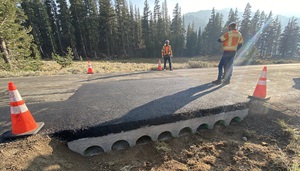
Now that it’s installed, toads have a safe option to cross the roadway.
Photo by District 9At the meadow, the Caltrans biologists were able to observe toads on several occasions using the crossings. Each time, the toads crossed through the invisible 3mm NIR beam and triggered the camera to start filming. The camera is a standard PIR wildlife camera reprogrammed to accept the Hobbes trigger.
It is too early to know whether the structures benefit the toads. Researchers at the USGS will process the data from the 2022 pilot study during the upcoming winter season. As with other wildlife crossings, the toad crossings may also benefit other species. Montane voles, ground squirrels, deer mice, and shrews have all been caught on camera using the crossings.
“Currently, there are no standard crossing structure plans for Yosemite toads. If the research proves the structures effective, we hope to develop standard plans for use on other California roads with adjacent Yosemite toad habitat,” Aalbu remarked.
The efforts in District 9 have already yielded benefits beyond the district. Rodriguez noted that District 9’s collaboration with external partners to develop potential low-cost strategies that improve connectivity and reduce roadkill had gained the attention of other Caltrans districts with protected amphibian species. “We hope the results of our study can improve connectivity for amphibians state-wide,” Rodriguez said.
The toad crossings in District 9 are evidence of Caltrans bringing forward efficient and innovative solutions through strategic partnerships to take on challenges large and small.
Caltrans wins national communications award
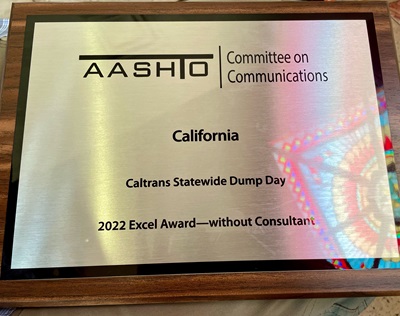
By Tamie McGowen
Assistant Deputy Director of Public Affairs
I’m excited to share that Caltrans won a top national award this last week from AASHTO’s Subcommittee on Transportation Communications – known as TransComm. Caltrans earned an Excel Award for “best campaign without a consultant” for the department’s communications and promotions effort surrounding the Clean California Statewide Dump Day event held earlier this year on April 23.
Caltrans held the statewide event at 30 locations throughout California in celebration of Earth Day. This was the first event of its kind for the department and required a coordinated effort, both internally with various Caltrans divisions and districts throughout the state to ensure a successful event, and externally with state and local partners to ensure maximum participation from Californians.
Caltrans conducted outreach to cities, counties, waste management companies, elected officials, and more to find locations to host this event and foster partnerships to get more public turnout. Not all events looked alike, some were focused on collecting old tires, others focused on large household items and appliances. Through careful coordination with local partners, Caltrans made sure to create events that met the needs of the communities they intended to serve. Promotion included social media posts and local news coverage to encourage Californians to come out and participate in the statewide event. Following the event, a press release was sent out and a video was created to communicate the success of the event and the amount of litter and debris collected. You can watch the video here: https://youtu.be/digNyWr5ppY
Caltrans used this event as a platform to educate participants and the public about the importance of properly securing all cargo loads and disposing of trash in receptacles and the impacts litter has on their communities.
AASHTO sponsors the annual skills awards competition to facilitate the sharing of best practices and to recognize outstanding communications efforts from state DOTs nationwide.
High-tech help is on the way for first responders

Jeremiah Pearce, left, discusses and demonstrates the Responder system at the ITS World Congress.
Photo by Haleigh PikeBy Haleigh Pike
District 2 public information officer
A new communication tool could be making its way to Caltrans soon and one of our very own from District 2 is on the team that’s working to make it happen.
Jeremiah Pearce, chief of the Office of ITS Engineering and Support in District 2, has been working on this project, along with the Caltrans Division of Research, Innovation and System Information (DRISI) and the UC Davis Advanced Highway Maintenance and Construction Technology (AHMCT) Research Center, for the past seven years. This project was initially championed by Ian Turnbull, who is now retired, in 2004 but it was shelved for several years while the technology industry caught up to Ian’s vision. It’s being called “Responder” and it will allow Caltrans to collect and share at-scene information quickly and efficiently.
As first responders, Caltrans maintenance staff must collect information, determine appropriate response, and access and manage resources at-scene. Currently, Caltrans does not have an efficient way to do that and our maintenance staff in District 2 face an even bigger challenge as our state highways go through rural areas with limited or no data network access.
Jeremiah, along with the other team members, have finalized the third generation of the Responder system, which uses a smart device such as a tablet or smartphone to operate.
Using GPS, the system automatically downloads local weather, retrieves maps and aerial photos, and pinpoints the Responder’s location and sends that information to the Transportation Management Center (TMC) and other parties when the operator presses “send.” The Responder system uses cellular when it can and satellite in areas with no other communications. It allows first responders to concentrate on work at the scene rather than being burdened with data input and reporting.
The Responder system has been tested in several Caltrans districts and was pilot and field tested in District 2. Positive feedback was received, further reiterating the need for a tool like this.
In addition to developing an incredibly successful device that will likely change the future of communication within Caltrans, the team working on the Responder system was also invited to ITS World Congress to demonstrate the new system. ITS World Congress is a global event that brings together world leaders, practitioners, policy makers, researchers, and private industry to advance and unite the intelligent transportation systems industry.
That signpost up ahead? It's the bee zone

Some 10,000 honeybees were found in an old wooden pole along State Route 246 in Lompoc.
Photo by Alexa BertolaBy: Alexa Bertola
District 5 public information officer
An un-bee-lievable 10,000 honeybees were rescued from a signpost in Lompoc on Sept. 16.
The massive swarm was discovered inside a wooden pole with signage warning of a stop sign ahead along eastbound State Route 246, west of V Street.
Super Bee Rescue of Santa Barbara removed the winged insects, wax and honey.
The company’s owner, Beevangelist Nick Wigle, said the 12-foot hive had some honey but not much, a possible indication that bees are getting stung by California’s severe drought.
He believes the bees entered the signpost through some holes at the bottom and that they have been living there on and off for years.
The signpost was removed to prevent any future issues.
Wigle relocated the bees to his yard where he will care for them and nurse them back to health. This is the second time this year Caltrans District 5 staff have discovered bees in a signpost, and later contributing to their safety.
Charge! Visalia yard has gone green

District 6's battery-powered light towers can run all night on a single charge.
Photo by Mark PetonBy Mark Peton
District 6 Maintenance
Visalia Maintenance has made some changes in the way we do business, specifically regarding combustion engines. We are going green!
I did the footwork for the San Juaquin Valley Air Pollution Control District Commercial Voucher Program and received $7,000 for battery-powered chainsaws and pole saws. Dirk Lopez purchased battery-powered blowers.
We received our new all-electric UTV vehicle, Tuatara.
We also purchased new light towers for emergency response and planned night work. These Milwaukee light towers are battery-powered and will run all night on a single charge and provide 27,000 lumens of light.
The blowers will run for up to 536 minutes and the chainsaws run for 60 continuous minutes.
There are advantages to battery-power tools. If you get called for an emergency at 2 a.m., clearing a down tree for example, there is no noise. No complaints for waking up nearby residents.
Another advantage is no more gasoline concerns. No spills and no fire hazards.Fast and efficient: New bridge in District 2
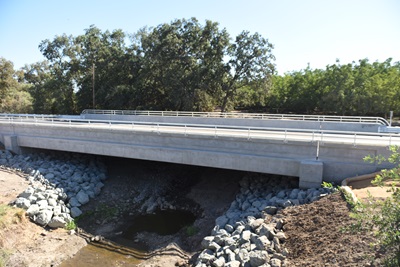
The new Champlin Slough Bridge along State Route 99E in Tehama County was done with Accelerated Bridge Construction technologies.
Photo by Kurt VillavicencioBy Kurt Villavicencio
District 2 public information officer
Commuters have been crossing over the Champlin Slough Bridge, one of Tehama County’s oldest commuter structures for over a century.
This bridge has provided a connection among the communities of Red Bluff, Los Molinos and Chico along State Route 99E for generations. It has carried cars, trucks, horses, buggies, tractors and just about anything you can think of over the Champlin Slough.
Like every structure, this bridge had a life span and Caltrans District 2 project manager Javed Iqbal was tasked with one of the most important (and highly visible) bridge replacement projects in Northern California. This project was particularly unique among the many structure projects throughout the district.
“This project is unique because we used Accelerated Bridge Construction technologies to reduce the impact to the traveling public by reducing the number of working days from six months to six weeks,” Iqbal said. “This reduction in working days greatly reduced the exposure of public traffic, field construction workers, and our staff to the construction zone traffic safety hazards and resulted in zero traffic-related injuries on the job.
“The environmental, utility, and private land impacts were also greatly reduced by closing SR-99E and thus avoiding the need to construct a temporary detour bridge beside the existing bridge.”
No detour bridge and the closure of a major North State route are added obstacles for any Caltrans team. From the beginning planning stages in 2016, to the completion of the new replacement bridge during the summer of 2022, the Champlin Slough Bridge Replacement presented challenges few other projects in the district encompassed.
“Traffic management and public awareness were the biggest challenges during this project. Caltrans PIO, District 2 Construction and Traffic Management did a tremendous job keeping the public informed and up to date as the project progressed through the six-week construction period,” Iqbal said. “Keeping the local transportation agencies and emergency responders up to date was another challenge that demanded great teamwork.”
It has been a complete team effort to complete the bridge replacement ahead of Tehama County’s busy construction season in 2023. Despite the challenges of replacing a bridge in the middle of one of the most traveled district corridors, Iqbal looks back at this project with gratitude.
“I’d like to take this opportunity to relay my appreciation to the team for their amazing dedication and coordination to overcome the challenges and make this project another success story,” Iqbal said. “It takes the whole team to create a success story. I’d like to thank the key team members that worked on this project that made it such an accomplishment. It’s been one of the more impressive engineering feats we’ve pulled off here in District 2.”Everyone plays a role in boosting safety
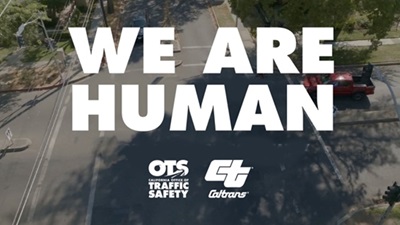
Note: The following news release was distributed earlier this month by the California Office of Traffic Safety and Caltrans.
The California Office of Traffic Safety (OTS) and California Department of Transportation (Caltrans) released a new “Go Safely” public service announcement emphasizing the role all road users play, and the responsibility they share, in keeping themselves and others safe.
Titled "We Are All Human," the 15, 30- and 45-second PSAs recognize that as people, we will inevitably make mistakes, but they do not need to result in serious or tragic consequences on the road. The videos will feature road "mistakes" to highlight actions everyone can take to "go safely," whether you are walking, biking, riding, or driving.
Initially launched in 2018, "Go Safely, California" is a comprehensive education and encouragement campaign that places a top priority on safe travel habits.
"Educating the public on safe driving behaviors is one of multiple tools – along with enforcement against dangerous behaviors, safer road designs with safer speeds – that are needed to provide multiple layers of protection for everyone on the road," OTS Director Barbara Rooney said.
“No longer can we as a society accept traffic deaths as routine,” said Caltrans Director Tony Tavares. “With the Safe System approach, we are focused on changing individual behaviors as well as the system itself to be more forgiving, enabling every driver, passenger, bicyclist and pedestrian to arrive at their destination safely, every time.”
The campaign includes fundamental principles and elements of the “Safe System” Approach, which emphasizes safer street design, safer vehicles and safer people all working in concert to make crashes, when they do happen, less severe.
The new PSAs will run throughout October on digital platforms, as well as audio messages on radio and streaming services. The new PSAs will also feature the winner of the ‘Get Off Your Apps’ video contest, which encouraged Californians to create a video showing the dangers of distracted driving, and what they do to not drive distracted. Roger Lua’s winning video landed him a role in the new PSAs, which were filmed last month in Sacramento.
To view the PSAs and learn about ways to stay safe on the go, visit www.gosafelyca.org.
San Luis Obispo seeks safer streets for all
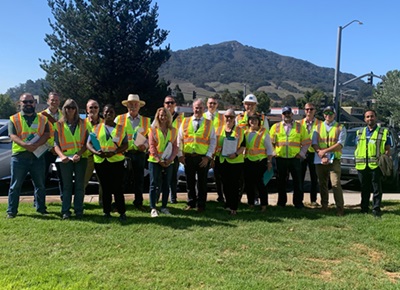
A group of District 5 employees participated in San Luis Obispo Council of Government’s (SLOCOG’s) two-night 2022 Regional Safe Streets Forum.
Photo by District 5By Alexa Bertola
District 5 public information officer
Caltrans is continuing its goal to enhance and connect the multimodal transportation network with an increased focus on all users, a group that includes bicyclists and pedestrians.
A group of District 5 employees further explored transportation safety for all modes in the San Luis Obispo region during San Luis Obispo Council of Government’s (SLOCOG’s) two-night 2022 Regional Safe Streets Forum.
The group also attended a SLOCOG led Road Safety Audit primer in the morning that targeted pedestrian concerns at the intersection of State Route 1 and Foothill and the surrounding area.
The community as well as local, regional, state and federal partners attended the invitation-only forum with the goal of together, we can all work toward better, more effective solutions.
Time to follow through on Our Promise

By the Employee Assistance Program
Note: The following message was emailed to all Caltrans employees on Oct. 20 by Aaron Ochoco, deputy director of the Caltrans Administrative Program.
The Caltrans Our Promise campaign is officially underway. I’d like to thank all you for your continuous support and generosity for our communities through this campaign. I also would like to thank all the Key Connector volunteers who have stepped up throughout each District and HQ Division to help make this year’s campaign a successful one.
I’d like to share CalSTA Secretary Toks Omishakin’s video message about the 65th year of the Our Promise Employees Giving at Work Campaign. We are honored by the Secretary’s continued support for the campaign and hope this message will inspire everyone to participate.
Please reach out to Our.Promise@dot.ca.gov with any questions about the campaign.
Health and Safety
Knowing the signs of crisis

By the Employee Assistance Program
A person can experience an emotional crisis for many reasons: loss of a job, the break-up of a relationship, financial problems, death of a loved one, or any other distressing event.
A person in crisis may feel such psychological pain that they can’t think clearly, make decisions, and have trouble functioning. Other signs of an emotional crisis, especially for someone who is depressed, include the following:
- The person talks about feeling hopeless, has no reason to live, or wants to die. • The person talks about being in unbearable pain with no way out, or feels like a burden to others. • Increased use of alcohol or drugs.
- Decline in performance at work or school.
- Loss of interest or pleasure in usual activities.
- Acting anxious or agitated; behaving recklessly.
- Withdrawal from others.
- Extreme mood swings.
- Dramatic changes in eating or sleeping habits.
You can show support to someone in crisis by staying calm and listening without judging or acting shocked. A person under extreme emotional distress may be at risk of hurting themselves or others. If you are concerned about the person’s mental state or safety, it’s important to ask if they’ve been thinking about hurting themselves.
You aren’t “planting” the idea of suicide by asking direct questions. Research shows that people who are having suicidal thoughts feel relief when someone asks these questions in a caring way. Show that you care and want to help.
If the person is considering suicide and has a plan, especially a detailed plan, the immediate risk is greater. It’s important to get professional help from a mental health provider, physician, or suicide/crisis hotline even if the person argues or resists. You can also encourage the person to contact their therapist if they have one.
Don’t leave the person alone while waiting for help, and remove any objects that can be used in a suicide attempt.
The National Suicide Prevention Hotline can be reached by calling 988 or 1-800-273-8255. If the person is in immediate danger, call 911.
Hospitalization is often necessary after a suicide attempt or when a person’s risk of suicide is high. Once the person is medically stable, therapy with a trained professional can help him or her recover.
Antidepressants and other medications may be prescribed in addition to therapy. Addiction treatment may be necessary if the person is also struggling with alcohol or other drugs.
As with other major illnesses, recovery is a process.
Hats Off
Sweet Tweet
District 9's Twitter efforts recently received a kudos from the Twitterverse. The district's tweet is shown below, and below that is the comment it received.

The tweet

The comment
Who’s New
Crystal McIlroy, Director’s Office executive analyst

Crystal McIlroy
Crystal McIlroy is a new executive analyst in the Director’s Office.
She started her career with Caltrans as a PI Dispatcher Clerk in February 2011 at the District 3 TMC, promoting to permanent full-time dispatcher clerk at the Headquarters Communications Center later that same year.
In early 2012 Crystal became an office technician (typing) for the Administrative Services team under the Division of Business Operations. In January 2013 she transferred to the Division of Equipment and served as staff administrative support for the Office of Maintenance and Repair.
In 2017 she worked an out of class assignment as an SSA, working as the executive analyst for the Division of Equipment Executive Staff, and promoted permanently to the position in January 2018.
Crystal is a third-generation Caltrans employee, following in the footsteps of her mother, father, uncle and grandfather (all retired).
In her time off she enjoys spending time with her young son and three dogs, going on road trips and visiting with family.
Jimmy O’Dea, assistant deputy director for transportation electrification

Jimmy O'Dea
Note: The following email was distributed Aug. 15 by Caltrans Chief Deputy Director Michael D. Keever.
Jimmy O’Dea is the new assistant deputy director for transportation electrification and works out of the Director’s Office of Sustainability.
As part of its commitment to climate action, Caltrans will continue its unrelenting efforts to reduce greenhouse gas emissions from the transportation sector. Electrifying our transportation network and accelerating the deployment of zero-emission vehicles (ZEVs) and charging infrastructure – and also championing the transition to zero-emission transit, rail, and freight systems – will be key in the fight against the climate crisis.
Jimmy comes to Caltrans with 18 years of experience in zero-emission vehicles and policy. He was previously deputy director of trucks at CALSTART, where he worked with businesses to advance federal and state policies supporting the widespread electrification of medium- and heavy-duty vehicles, including the “Commercial Clean Vehicle” tax credit in the Inflation Reduction Act.
Prior to joining CALSTART, Jimmy was senior vehicles analyst at the Union of Concerned Scientists, where he played key roles in the strengthening and adoption of first-of-their-kind policies for electric trucks and buses, including the Advanced Clean Trucks and Innovative Clean Transit standards in California. Jimmy was a Science and Engineering Congressional Fellow in the office of U.S. Senator Brian Schatz (D-Hawaii). In postdoctoral and graduate research in chemistry at Cornell and UC Santa Barbara, he studied materials used in fuel cells, batteries and solar cells.
Over the next few months, Jimmy and the Director’s Office of Sustainability will be working with many of you to re-orient and set a new direction for this next chapter of our journey toward a zero-emissions transportation system. Please join me in welcoming Jimmy to the Caltrans family!
Daniel Rubinstein, Director’s Office executive manager

Daniel Rubinstein
Daniel Rubinstein is the Director’s Office new executive manager.
He previously worked in the Director's Office at the Department of Managed Health Care, where he was an acting manager and analyst in the administrative unit. Previously, Daniel was an analyst in the Office of the Secretary of the Labor and Workforce Development Agency, an Assembly intern, and a student assistant at the Secretary of State's.
Daniel graduated summa cum laude from California State University, Sacramento with a bachelor's in political science. He is a native Sacramentan and a first-generation American of Ukrainian descent.
Daniel can be found at the gym or a cafe in his free time.
Ryan Snyder, Director’s Office executive liaison

Ryan Snyder
Ryan Snyder who is serving as the Director’s Office executive liaison through February 2023. Ryan comes from Caltrans District 7, where he was the senior transportation planner/manager of Sustainability. Ryan headed up a number of projects including the Zero Emission Infrastructure Plan, plans to get solar panels in our rights-of-way, mobility hub planning, and reconnecting communities.
Prior to Caltrans, Ryan was a principal in transportation consulting. Much of his career has been with active transportation planning, having prepared many bicycle, pedestrian and safe routes to school plans.
Ryan started his career in transportation demand management (TDM) and has also done some transit planning. He coordinated the development of the Model Design Manual for Living Streets and has prepared other street design manuals for regions such as Las Vegas and Honolulu. He also coordinated the AV Policy Framework Summit that brought some 100 national experts together to advance the policy discussion on how to prepare for a future with automated vehicles.
Ryan taught graduate students at the UCLA Urban Planning Department for seven years, and served as vice president of the Los Angeles Board of Transportation Commissioners.
Ryan holds an M.A. in urban planning and a B.A. in economics from UCLA.
His primary mode of transportation is a bicycle. In his spare time, he likes outdoor activities like swimming, snorkeling, hiking, exploring new places and eating out. He loves to travel and enjoys studying languages.
Walter Yu, Clean California Program’s principal transportation engineer

Walter Yu
Walter Yu is the Clean California Program’s new principal transportation engineer.
As a graduate of UC Berkeley, Walter began his Caltrans career in 2006 with District 4 as a transportation engineer. He joined the Division of Environmental Analysis in 2016 as a senior transportation engineer. Next, he joined the Planning and Modal Programs as Caltrans Enterprise Data and Geospatial Governance Program manager.
During the course of his more than 16‑year career, Walter has worked on a variety of new initiatives including the District 4 Construction Stormwater Inspection Program, Caltrans Statewide Trash Implementation Plan for the State Water Resources Control Board, and Enterprise Data Governance Task Force.
Since 2021, Walter has served as a Clean California Program Manager, responsible for program implementation including the Local Grant Program. He also supported the State Beautification Program and Division of Maintenance litter eradication efforts.
In his free time, Walter enjoys spending time with family, volunteering with Code for America as co-chair of the Sacramento and Fresno chapters, and was recently admitted into the Master of Science in Transportation Management Program at San Jose State University for the spring 2023 semester.
Obituaries
Yoon Jong Hahn, longtime civil engineer

Photo courtesy of Yoon Jong Hahn's family
Note: The following obituary appeared on the Tribute Archive website in early July.
Longtime Caltrans civil engineer Yoon Jong Hahn, 55, died unexpectedly on July 2 at his home in Rancho Cordova.
He was born in Incheon, South Korea, on Nov. 17, 1967, and graduated from high school in that city. He was one of the top students excelling in his academics.
He moved to the United States when he was 18 and graduated from California State University, Sacramento with a bachelor’s in civil engineering. He was employed with Caltrans for 29 years and was recognized as a distinguished civil engineer.
He was the son of Song Que Hahn and Sook Ja Bak. He married Linda Sungwon Chon on July 29, 2000. He was very proud of their son, Vince Seung Chul Hahn.
Yoon Jong Hahn was a member of the Sacramento Korean Presbyterian Church in Rancho Cordova. He enjoyed fishing, electronics and automobiles.
His co-workers described him as generous, gregarious and always very helpful to new Korean
immigrants coming here from South Korea.
Survivors include his wife, Linda Sungwon Chon; son. Vince Seung Chul Hahn; father, Song Que Hahn; mother, Sook Ja Bak; sister, Yoon Sook Hahn; step-mother, Lani Hahn; and many aunts, uncles and cousins in South Korea and the United States.
Retired right-of-way agent John E. Hermann

John E. Hermann
Photo courtesy of John's family
Note: The following obituary appeared on Sept. 10 in the online edition of the Coronado Eagle & Journal.
Retired right-of-way agent John E. Hermann, a long-time resident of this community, passed away on Sept. 10.
His introduction to Coronado occurred in 1952 when he reported for duty at the Amphibious Base here upon completing his Vanderbilt University degree with a NROTC scholarship. After serving on the USS Washburn during the Korean War, John was honorably discharged in San Diego and decided to make Coronado his home. He bought a house on E Avenue, from which he made a point of going to the beach each day.
Over the years he owned many apartment complexes in this community. As a right-of-way agent for what is now Caltrans, John rode the Coronado ferry on his motorcycle (15 cents for cycles) until the bridge was completed. The ferry and then the bridge also provided active conduits for his community involvement.
He sang in the San Diego Opera chorus for 18 years and near his retirement from the opera was named the “outstanding residential artist.” John also assumed an active board role in “Meals on Wheels” and received a special award for his service in 2011.
Two fundamental anchors in his life were BMW motorcycling and the First United Methodist Church of San Diego. John rode 1 million miles on BMW motorcycles — often in one of his favorite locations — the European Alps. His guidebook on motorcycling in the Alps is now in its fifth edition.
From his arrival in the San Diego area, John served in many lay capacities in the First United Methodist Church, where his funeral will be held at 1 p.m. on Nov. 6. His enthusiastic spirit lives on in his vast network of friends.
Clinton D. Hersey, retired heavy equipment operator

Clinton D. Hershey
Photo courtesy of Clint's family
Note: The following obituary appeared on the Record-Courier (Gardnerville, Nevada) website earlier this year.
Retired heavy equipment operator Clinton D. Hershey was born in Bakersfield on June 17, 1941, to Ethel Lorain and Richard Marion Hershey and passed peacefully in his sleep at his home in Walker on May 5.
He was 80.
Clint, the oldest of five children, grew up helping his grandparents at the Cottonwood Creek Pack Station, in Lone Pine. He graduated from East Bakersfield High School in 1960 and married Effie Lou Barbour on May 4, 1964. Clint and Effie were married for 50 years before she preceded him in death in 2014. They raised their two daughters, Janice and Daneece, in Walker.
Clint worked as a heavy equipment operator for Caltrans and retired with over three decades of service to the State of California. Clint diligently served his community as a member of the Antelope Valley Lions Club for 45 years, where he was the recipient of the Melvin Jones Fellowship Award to recognize his exemplary service to his club and the community. He received a perfect attendance award every year from the Lions Club and was also the recipient of the Lion of the year.
He was a generous man to his family, friends and community, giving of his time and his talents. He loved to golf and fish, travel with his wife Effie and close friends in their RV and go on adventures around the globe, which included destinations such as Scotland, South Africa, Mexico, the Caribbean and Canada.
Clint was preceded in death by his mother Lorain, father Richard, sister Sarah in 2000, daughter Janice in 2011, wife Effie in 2014, and brother Marvin “Pete” in 2022.
Clint is survived by his daughter Daneece Fraizer (Bob); sisters Becky and Linda; his grandchildren, Amanda Woolsey-Weber, Amber Woolsey, Nathan Eppler, Ian Fraizer and Sawney Fraizer; as well as three great-grandchildren, many nieces and nephews, and friends he considered family.
Clint was a devoted, husband, father, bother, uncle, friend and member of the community and he will be greatly missed by many who loved him.
Richard Schumacher, retired head of District 6 Hydraulics

Richard Schumacher
Photo courtesy of Richard's family
Note: The following email was distributed Aug. 14 by the Division of Research, Innovation and System Information.
It is with great sorrow that we announce the passing of Richard Schumacher. He was born April 4, 1935, in Hull, Iowa, and died on July 24.
Richard started his career at District 6, working in the Soils Lab in 1957. He worked in Traffic for the majority of the time following the Lab before going into private practice at Braun, Pacillas, and Wagner and then becoming the District Engineer at the Fresno Irrigation District.
Richard returned to Caltrans and was a District 6 Hydraulics Engineer and became head of District 6 Hydraulics before retiring in 1996. He was a lifetime member of American Society of Civil Engineers.
Richard is survived by wife (of 64 and a half years) Kay Schumacher, daughter Debbie Campbell, son Gerald Schumacher (who works at Headquarters), brother Norman Schumacher, sisters Edith Schumacher and Irene Hansen, and granddaughter Katie Campbell.
Duane Sharp, retired Caltrans worker

Duane Sharp
Photo courtesy of Duane's family
Note: The following obituary appeared on The Spectrum website earlier this year.
Caltrans retiree Duane Leroy Sharp, 91, passed away peacefully on May 5 in St. George, Utah.
He was born on April 30, 1931, in San Bernardino to Herbert and Helen Sharp. He married Carol Thornton in Colton on May 6, 1955.
He worked for Caltrans for 28 years before retiring in 1994 and moving to Santa Clara, Utah.
He is survived by his wife; Carol, son; Kevin Sharp of St. George and daughter Kristy Christopherson of Southern California. He has four grandchildren: Jeremy , Jessica, Aidan and Gillian. He has three great-grandchildren: Marina, Remington and Wesson. He was preceded in death by his son, Kirk Sharp.

